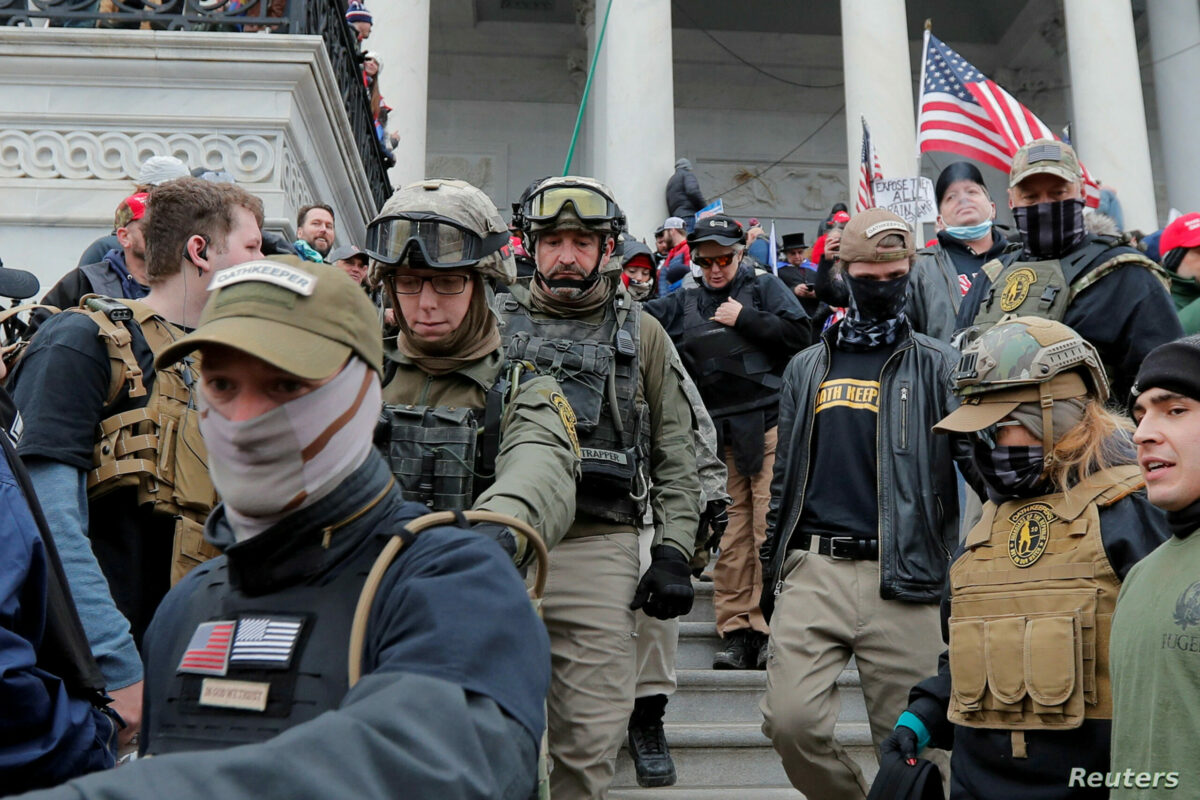Oath Keeper and alleged seditionist Edward Vallejo goes before a judge in Arizona Thursday for a detention hearing, but before he does, prosecutors laid out in sprawling new detail the extremist group’s long game to subvert the 2020 election with a plot that included stashing drones, firearms, and enough supplies to last for 30 days.
Vallejo is just one of the 11 members of the Oath Keepers charged last week by the Department of Justice with conspiracy to commit sedition. Prosecutors say he and other defendants, including former Oath Keeper leader Elmert Stewart Rhodes, were engaged in a comprehensive and violent conspiracy to stop President Joe Biden from taking office.
According to Vallejo’s initial indictment, he was allegedly in charge of leading quick reaction force teams that could supply fellow extremists in D.C. on Jan. 6 with weapons. Vallejo allegedly worked closely with Rhodes before, during, and after the attack, and though some details of the plot were revealed last week, the pretrial detention memo offers further chilling insights.
Vallejo and others were positioned at the Comfort Inn Ballston in Arlington, Virginia, just a 15-minute drive from the Capitol. The plan to unite quick reaction force teams headed to D.C. began to gather steam last New Year’s Eve; prosecutors said a Dec. 31 text message sent from Vallejo indicated that he and others were headed to D.C. where teams had “dropped off at least three luggage carts’ worth of gun boxes, rifle cases and ammunition.”
While another team had rifles stowed and at the ready in a car parked at the same hotel, Vallejo was seen on security footage transporting the weapons cache in huge bins.
There were enough “weapons, ammunition and essential supplies to last 30 days,” the memo states.
Vallejo also tried and failed to launch a drone equipped with a camera for “recon,” or reconnaissance, prosecutors said.
Vallejo Pretrial Detention … by Daily Kos
But the conspiracy didn’t end there: Well into the afternoon of Jan. 6, and even as law enforcement was working to secure the Capitol’s perimeter, Vallejo was texting fellow alleged plotters.
Just around 4:45 PM, another conspirator wrote to Vallejo in an encrypted Signal chat: “So, why are we leaving??? It does NO good to show up and say your there to defend and just leave.” [Punctuation and spelling original.]
Vallejo replied: “Leaving?!? I ain’t going nowhere… My statement was to assure Arizona won’t let anyone walk.”
He added: “We will monitor all night and transport anyone that meets us on the perimeter curfew be damned.”
That same night around 7:30 PM, Rhodes messaged Vallejo and others, writing that “thousands of ticked off patriots spontaneously marched on the Capitol” and ‘You ain’t seen nothing yet.”
“Patriots entering their own Capitol to send a message to the traitors is NOTHING compared to what’s coming,” Rhodes said.
Vallejo’s text put his enthusiasm on bald display.
“We have only begun to fight! After Action Reports will be dated 1/21/21,” he wrote.
The “After Action Reports,” prosecutors say, were a reference to the day after Biden’s inauguration.
“Although enforcement at the Capitol had successfully repelled the efforts of the conspiracy to take the Capitol on January 6, Vallejo’s words make clear that the conspiracy would continue up and through the presidential inauguration,” the memo notes.
Early on the morning of Jan. 7, just a few hours after the certification of electoral votes had finally concluded in the Capitol, Vallejo wrote to his cohorts again in an encrypted chat saying his team was going to “probe their defense line right now 6 am.”
“They should let us in,” he added. “We’ll see.”
Later that morning, Vallejo appeared on a podcast and spoke about the siege, saying that it was “not really plausible” to engage in nonviolent protest because Washington was effectively locked down and under curfew.
Vallejo also pondered aloud if Jan. 6 was the “shot heard ‘round the world moment.” When asked if he would return to Arizona or stay in D.C., he expressed uncertainty,
“i don’t know. We’ve got to see what happens on the 20th. I’m never done … I’m waiting for orders from Stewart Rhodes.”
What unfolded in the weeks after the attack was a waterfall of messages between Oath Keepers as Rhodes allegedly purchased “thousands of dollars’ worth of firearms, munitions, equipment” and summoned co-conspirators to join him in Texas.
During his initial court appearance last week, Vallejo indicated he would enter a not guilty plea when he is finally arraigned.
The messages alone could prove an insurmountable hurdle for the 63-year-old Phoenix resident. Many of Vallejo’s cohorts “took steps to destroy evidence” related to their involvement or communication about the sedition plot, and Rhodes warned Vallejo about a “turncoat” in their mix.
Recent social media posts aren’t conducive to Vallejo’s copping of a not guilty plea either. Nearly a full year after the attack, which left hundreds of police injured and several people dead, Vallejo retweeted a message that said: “There was NO INSURRECTION on J6 just a peaceful protest.”
Even up to two weeks ago, on Jan. 8, Vallejo retweeted another similar missive that said: “The real insurrection happened in the wee hours of Nov. 4, 2020.”
Vallejo goes before a magistrate judge Thursday afternoon in Phoenix, where it will be decided whether he can be released pending his trial.
